
Power Integrity Analysis
AEi Systems Offers Power Integrity Analysis as a service. Using your boards files, we analyze the design, creating all the necessary VRM, decoupling capacitors, bead, and PDN models. We generate the PDN impedance and Regulator Noise and assess system performance.
PDN Analysis - Benefits are HUGE
- Identify power distribution problems early
- Reduce prototype and production board spins
- Identify difficult-to-troubleshoot PCB problems
- Improve Memory, FPGA and High-Speed Circuitry Reliability
PDN Analysis - Why you need to perform this analysis
- Impedance profile impacts regulation margins - Must be flat!
- Decoupling is not intuitive - Value selection complex
- Need to take the PCB into account
- Capacitor and Via placement is critical
- The VRM impedance impacts the PDN - VRM, Plane, and IC all interact
- On-Die parasitics are not always known - Simulation allows exploration and bounding
- Need to understand crosstalk and plane noise propagation
- Rules of Thumb are insufficient
- Part Tolerances DRAMATICALLY Impact PDN Impedance Resonances
- Test is expensive and often impractical - Especially if there is no hardware
Power Integrity has become a huge concern for all designs. Power distribution network (PDN) design continues to be a major challenge in electronic systems. Integrated circuit performance is directly related to the quality of power distribution networks. Circuit timing and jitter characteristics are a strong functions of noise on the power supply. The quality of on-die power, jitter, and timing performance are highly dependent upon the PDN. Designing a clean and reliable power delivery network for a PCB design is a challenging but necessary exercise. It normally takes at least two (2) board spins to get right.
Bulk
Decap
PCB
Decap
Package
Decap
Figure 1. Components of a PDN system
The major components of the power delivery network are the die, package, the PCB
planes, vias and traces, and the voltage regulator module. There are also several
types of decoupling capacitors as well. The role of the decoupling capacitors is
to help the voltage regulator supply current when there is high demand. Each of
the system components contributes to the overall inductance of the PDN. Even the
capacitors themselves have an inductance (ESL) that plays a role. The goal is to
decouple this inductance to maintain the target impedance.
While Power Integrity analysis has been a very active field, in recent years it
has started to attract more attention and it now shares the stage with Signal Integrity
as one of the top concerns for high-speed digital designers. From the perspective
of a high-speed digital designer, Power Integrity analysis involves looking at how
the entire power delivery network responds when there is a change in current (di/dt)
and how that affects the power rail that is connected to chips on the PCB. Since
the entire PDN is inductive, when you have a large change in current, the power
rail will droop due to L * di/dt. A droop (or bounce) in your power and ground rails
can cause timing errors at your receiver inputs and add jitter to your sensitive
interfaces. It is desirable to keep the power rail noise within a specified range
to limit the impact on your system margins.
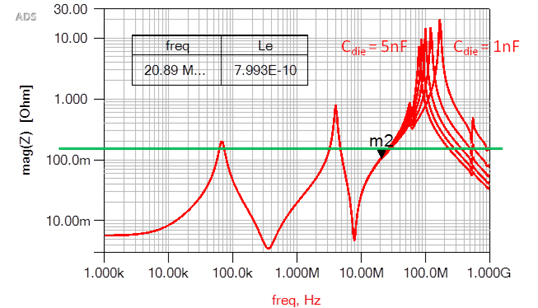
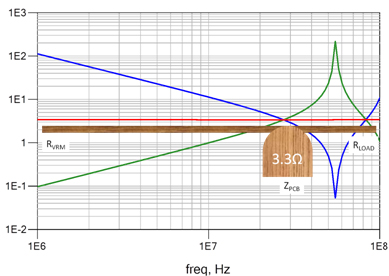
The major concern is the transient noise caused by the interaction of the PDN impedance
with the dynamic currents of the FPGA, memory, and other high speed loads. As voltages
levels are reduced and edge speeds increase, the window of acceptable voltage range
narrows, reducing margins especially in the worst case. Computing just the DC component
is not sufficient. The largest contributor is often the transient load step excursions.
In the past, this was assessed by load stepping the regulator. This is no longer
adequate given what we care about is the voltage at the load, not at the VRM output.
Worst Case PDN Analysis of an RTAX2000 Power Rail
Worst Case Impedance Analysis of RH3845 and RHFL4913 Power Rails
What AEi Systems Power Integrity Analysis Offers
- PDN Analysis, Simulation and Testing Expertise and Support
- VRM and Decoupling Measurement, Modeling, and Optimization
- Target Impedance Assessment
- Worst Case Noise and Transient Step Load Computation
- Support for ADS and Mentor Tools and Flows
- Support for VNA Hardware measurement using state of the art Instruments and Probes
- Capacitance and Bead Measurement and Characterization
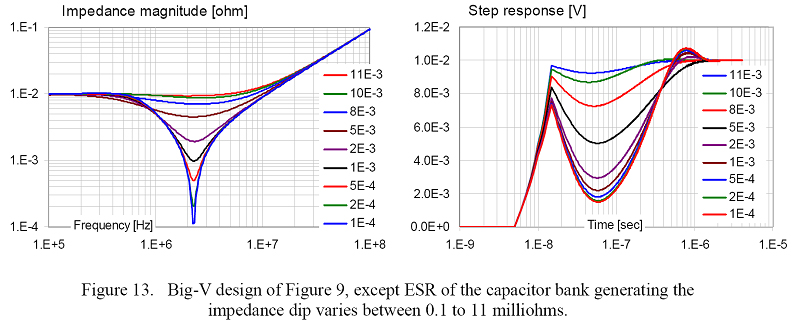
The goal therefore, is two-fold, to achieve a flat impedance and to meet the target
impedance. Both of which are essential to managing transient noise.
The only way to do this is to assess the PDN impedance. This is what AEi Systems
Power Integrity analysis does for you. IMAGE
There are interactions between the VRM, electrolytic bulk decoupling capacitor,
high frequency ceramic decoupling capacitors, the power plans, and the package PDN
can be effective up to a few hundred megahertz. Tolerance further impact the impedance
peaks and resonances.
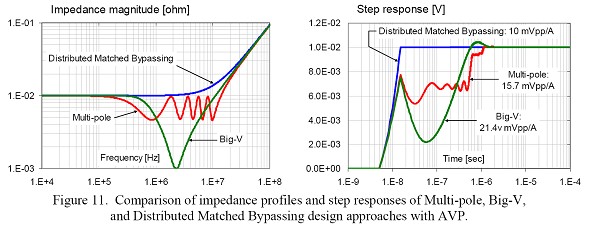
Comparison of Power Distribution Network Design Methods: Bypass Capacitor Selection
Based on Time Domain and Frequency Domain Performances, Istvan Novak, DesignCon
February 6-9, 2006, Santa Clara, CA
There are many methods available to model the entire PDN in order to validate if
the target impedance has been met. AEi systems employs a variety of tools tool such
as Keysight’s ADS and Mentor’s Power Integrity Wizard to do the model extraction.
From a high level, these tools will use internal field solvers to calculate the
S-parameters of the path from the die to the VRM, including the power and ground
planes along with the vias. VNA measurements are often use to supplement the VRM
and capacitor data, which is often non-existent. The VRM cannot be modeled as an
ideal voltage source and in many cases not even as a series R-L.
With the extracted S-parameter model of the PDN from the die to the VRM, both time
domain and frequency domain simulations can be performed. The above diagram shows
the frequency response of the PDN.
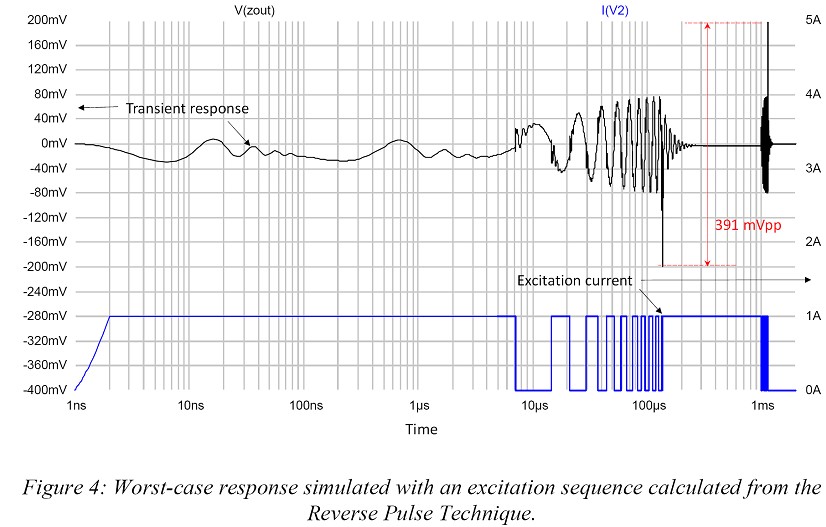
Analysis | SPICE Modeling | Publications
Home | Services |
About Us | Contact Us | Jobs
Terms of Use | Site Map
©AEi Systems, Inc. All Rights Reserved.








